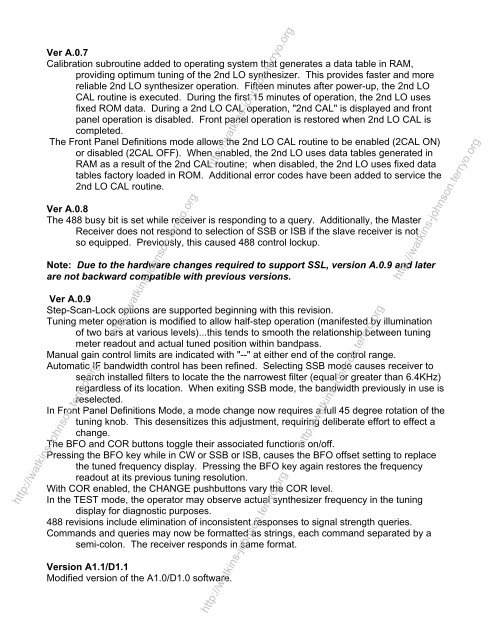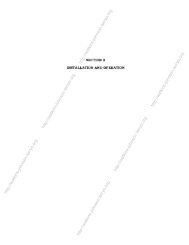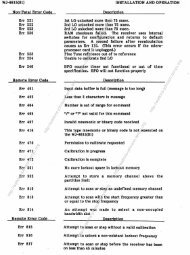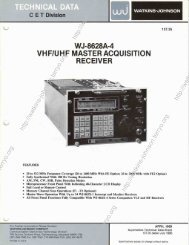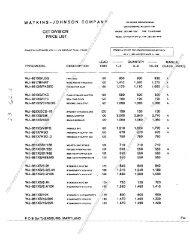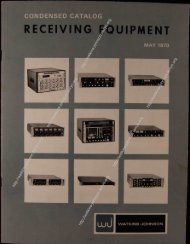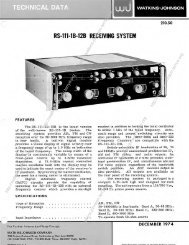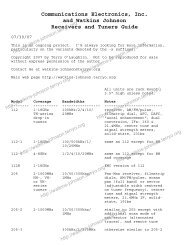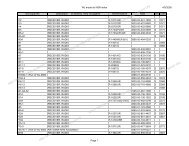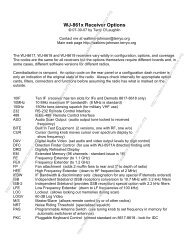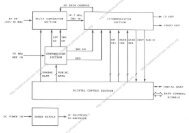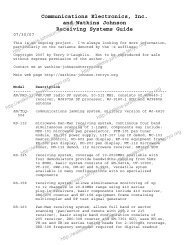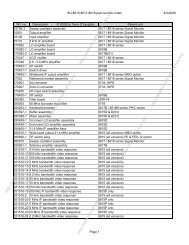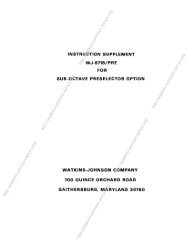WJ-8615 receiver versions - Watkins-Johnson
WJ-8615 receiver versions - Watkins-Johnson
WJ-8615 receiver versions - Watkins-Johnson
Create successful ePaper yourself
Turn your PDF publications into a flip-book with our unique Google optimized e-Paper software.
Ver A.0.7<br />
Calibration subroutine added to operating system that generates a data table in RAM,<br />
providing optimum tuning of the 2nd LO synthesizer. This provides faster and more<br />
reliable 2nd LO synthesizer operation. Fifteen minutes after power-up, the 2nd LO<br />
CAL routine is executed. During the first 15 minutes of operation, the 2nd LO uses<br />
fixed ROM data. During a 2nd LO CAL operation, "2nd CAL" is displayed and front<br />
panel operation is disabled. Front panel operation is restored when 2nd LO CAL is<br />
completed.<br />
The Front Panel Definitions mode allows the 2nd LO CAL routine to be enabled (2CAL ON)<br />
or disabled (2CAL OFF). When enabled, the 2nd LO uses data tables generated in<br />
RAM as a result of the 2nd CAL routine; when disabled, the 2nd LO uses fixed data<br />
tables factory loaded in ROM. Additional error codes have been added to service the<br />
2nd LO CAL routine.<br />
Ver A.0.8<br />
The 488 busy bit is set while <strong>receiver</strong> is responding to a query. Additionally, the Master<br />
Receiver does not respond to selection of SSB or ISB if the slave <strong>receiver</strong> is not<br />
so equipped. Previously, this caused 488 control lockup.<br />
Note: Due to the hardware changes required to support SSL, version A.0.9 and later<br />
are not backward compatible with previous <strong>versions</strong>.<br />
Ver A.0.9<br />
Step-Scan-Lock options are supported beginning with this revision.<br />
Tuning meter operation is modified to allow half-step operation (manifested by illumination<br />
of two bars at various levels)...this tends to smooth the relationship between tuning<br />
meter readout and actual tuned position within bandpass.<br />
Manual gain control limits are indicated with "--" at either end of the control range.<br />
Automatic IF bandwidth control has been refined. Selecting SSB mode causes <strong>receiver</strong> to<br />
search installed filters to locate the the narrowest filter (equal or greater than 6.4KHz)<br />
regardless of its location. When exiting SSB mode, the bandwidth previously in use is<br />
reselected.<br />
In Front Panel Definitions Mode, a mode change now requires a full 45 degree rotation of the<br />
tuning knob. This desensitizes this adjustment, requiring deliberate effort to effect a<br />
change.<br />
The BFO and COR buttons toggle their associated functions on/off.<br />
Pressing the BFO key while in CW or SSB or ISB, causes the BFO offset setting to replace<br />
the tuned frequency display. Pressing the BFO key again restores the frequency<br />
readout at its previous tuning resolution.<br />
With COR enabled, the CHANGE pushbuttons vary the COR level.<br />
In the TEST mode, the operator may observe actual synthesizer frequency in the tuning<br />
display for diagnostic purposes.<br />
488 revisions include elimination of inconsistent responses to signal strength queries.<br />
Commands and queries may now be formatted as strings, each command separated by a<br />
semi-colon. The <strong>receiver</strong> responds in same format.<br />
http://watkins-johnson.terryo.org http://watkins-johnson.terryo.org http://watkins-johnson.terryo.org<br />
Version A1.1/D1.1<br />
Modified version of the A1.0/D1.0 software.<br />
http://watkins-johnson.terryo.org http://watkins-johnson.terryo.org http://watkins-johnson.terryo.org


